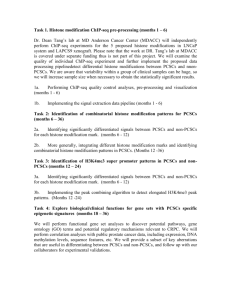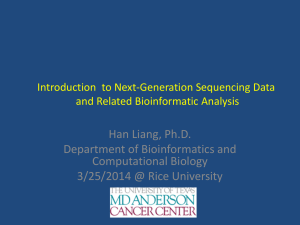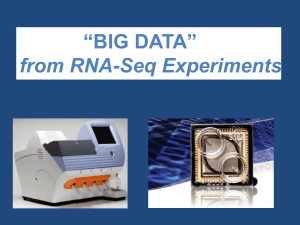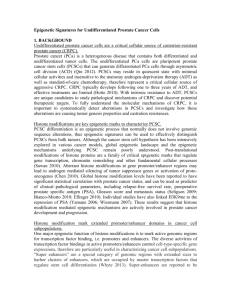PCSC Prostate Cancer Stem Cell - Wei Li Lab
advertisement
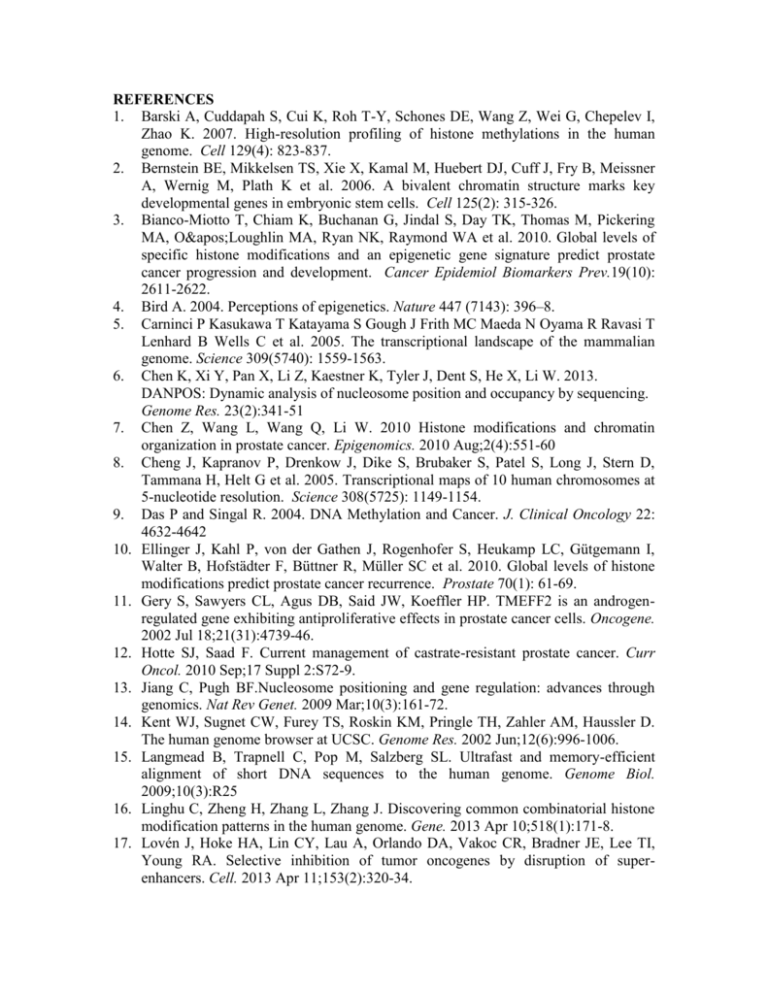
REFERENCES 1. Barski A, Cuddapah S, Cui K, Roh T-Y, Schones DE, Wang Z, Wei G, Chepelev I, Zhao K. 2007. High-resolution profiling of histone methylations in the human genome. Cell 129(4): 823-837. 2. Bernstein BE, Mikkelsen TS, Xie X, Kamal M, Huebert DJ, Cuff J, Fry B, Meissner A, Wernig M, Plath K et al. 2006. A bivalent chromatin structure marks key developmental genes in embryonic stem cells. Cell 125(2): 315-326. 3. Bianco-Miotto T, Chiam K, Buchanan G, Jindal S, Day TK, Thomas M, Pickering MA, O'Loughlin MA, Ryan NK, Raymond WA et al. 2010. Global levels of specific histone modifications and an epigenetic gene signature predict prostate cancer progression and development. Cancer Epidemiol Biomarkers Prev.19(10): 2611-2622. 4. Bird A. 2004. Perceptions of epigenetics. Nature 447 (7143): 396–8. 5. Carninci P Kasukawa T Katayama S Gough J Frith MC Maeda N Oyama R Ravasi T Lenhard B Wells C et al. 2005. The transcriptional landscape of the mammalian genome. Science 309(5740): 1559-1563. 6. Chen K, Xi Y, Pan X, Li Z, Kaestner K, Tyler J, Dent S, He X, Li W. 2013. DANPOS: Dynamic analysis of nucleosome position and occupancy by sequencing. Genome Res. 23(2):341-51 7. Chen Z, Wang L, Wang Q, Li W. 2010 Histone modifications and chromatin organization in prostate cancer. Epigenomics. 2010 Aug;2(4):551-60 8. Cheng J, Kapranov P, Drenkow J, Dike S, Brubaker S, Patel S, Long J, Stern D, Tammana H, Helt G et al. 2005. Transcriptional maps of 10 human chromosomes at 5-nucleotide resolution. Science 308(5725): 1149-1154. 9. Das P and Singal R. 2004. DNA Methylation and Cancer. J. Clinical Oncology 22: 4632-4642 10. Ellinger J, Kahl P, von der Gathen J, Rogenhofer S, Heukamp LC, Gütgemann I, Walter B, Hofstädter F, Büttner R, Müller SC et al. 2010. Global levels of histone modifications predict prostate cancer recurrence. Prostate 70(1): 61-69. 11. Gery S, Sawyers CL, Agus DB, Said JW, Koeffler HP. TMEFF2 is an androgenregulated gene exhibiting antiproliferative effects in prostate cancer cells. Oncogene. 2002 Jul 18;21(31):4739-46. 12. Hotte SJ, Saad F. Current management of castrate-resistant prostate cancer. Curr Oncol. 2010 Sep;17 Suppl 2:S72-9. 13. Jiang C, Pugh BF.Nucleosome positioning and gene regulation: advances through genomics. Nat Rev Genet. 2009 Mar;10(3):161-72. 14. Kent WJ, Sugnet CW, Furey TS, Roskin KM, Pringle TH, Zahler AM, Haussler D. The human genome browser at UCSC. Genome Res. 2002 Jun;12(6):996-1006. 15. Langmead B, Trapnell C, Pop M, Salzberg SL. Ultrafast and memory-efficient alignment of short DNA sequences to the human genome. Genome Biol. 2009;10(3):R25 16. Linghu C, Zheng H, Zhang L, Zhang J. Discovering common combinatorial histone modification patterns in the human genome. Gene. 2013 Apr 10;518(1):171-8. 17. Lovén J, Hoke HA, Lin CY, Lau A, Orlando DA, Vakoc CR, Bradner JE, Lee TI, Young RA. Selective inhibition of tumor oncogenes by disruption of superenhancers. Cell. 2013 Apr 11;153(2):320-34. 18. Pierconti F, Martini M, Pinto F, Cenci T, Capodimonti S, Calarco A, Bassi PF, Larocca LM. 2011. Epigenetic silencing of SOCS3 identifies a subset of prostate cancer with an aggressive behavior. Prostate. 71(3):318-25. 19. Puhr M, Santer FR, Neuwirt H, Marcias G, Hobisch A, Culig Z. 2010. SOCS-3 antagonises the proliferative and migratory effects of fibroblast growth factor-2 in prostate cancer by inhibition of p44/p42 MAPK signalling. Endocr Relat Cancer. 17(2):525-38. 20. Qin J, Liu X, Laffin B, Chen X, Choy G, Jeter CR, Calhoun-Davis T, Li H, Palapattu GS, Pang S et al. 2012. The PSA(-/lo) prostate cancer cell population harbors selfrenewing long-term tumor-propagating cells that resist castration. Cell Stem Cell 10(5): 556-569. 21. Rhodes DR, Kalyana-Sundaram S, Mahavisno V, Varambally R, Yu J, Briggs BB, Barrette TR, Anstet MJ, Kincead-Beal C, Kulkarni P, Varambally S, Ghosh D, Chinnaiyan AM. Oncomine 3.0: genes, pathways, and networks in a collection of 18,000 cancer gene expression profiles. Neoplasia. 2007 Feb;9(2):166-80. 22. Rosenbloom KR, Dreszer TR, Long JC, Malladi VS, Sloan CA, Raney BJ, Cline MS, Karolchik D, Barber GP, Clawson H et al. 2012. ENCODE whole-genome data in the UCSC Genome Browser: update 2012. Nucleic Acids Res. 40(Database issue): D912-917. 23. Sanz LA, Chamberlain S, Sabourin J-C, Henckel A, Magnuson T, Hugnot J-P, Feil R, Arnaud P. 2008. A mono-allelic bivalent chromatin domain controls tissuespecific imprinting at Grb10. EMBO J 27(19): 2523-2532. 24. Sawan C, Herceg Z. 2010. Histone modifications and cancer. Adv Genet. 2010; 70:57-85. 25. Seligson DB, Horvath S, McBrian MA, Mah V, Yu H, Tze S, Wang Q, Chia D, Goodglick L, Kurdistani SK. 2009. Global levels of histone modifications predict prognosis in different cancers. Am J Pathol. 174(5): 1619-1628. 26. Strahl BD, Allis CD. 2000. The language of covalent histone modifications. Nature 403 (6765): 41–5. 27. Subramanian A, Tamayo P, Mootha VK, Mukherjee S, Ebert BL, Gillette MA, Paulovich A, Pomeroy SL, Golub TR, Lander ES, Mesirov JP. Gene set enrichment analysis: a knowledge-based approach for interpreting genome-wide expression profiles. Proc Natl Acad Sci U S A. 2005 Oct 25;102(43):15545-50. 28. Suganuma T, Workman JL. Signals and combinatorial functions of histone modifications. Annu Rev Biochem. 2011;80:473-99. 29. Wang Z, Zang C, Rosenfeld JA, Schones DE, Barski A, Cuddapah S, Cui K, Roh TY, Peng W, Zhang MQ et al. 2008. Combinatorial patterns of histone acetylations and methylations in the human genome. Nat Genet. 40(7): 897-903. 30. Whyte WA, Orlando DA, Hnisz D, Abraham BJ, Lin CY, Kagey MH, Rahl PB, Lee TI, Young RA. Master transcription factors and mediator establish super-enhancers at key cell identity genes. Cell. 2013 Apr 11;153(2):307-19. 31. Wissmann M, Yin N, Muller JM, Greschik H, Fodor BD, Jenuwein T, Vogler C, Schneider R, Gunther T, Buettner R et al. 2007. Cooperative demethylation by JMJD2C and LSD1 promotes androgen receptor-dependent gene expression. Nat Cell Biol 9(3): 347-353. 32. Yamane K, Toumazou C, Tsukada Y, Erdjument-Bromage H, Tempst P, Wong J, Zhang Y. 2006. JHDM2A, a JmjC-containing H3K9 demethylase, facilitates transcription activation by androgen receptor. Cell 125(3): 483-495. 33. Zhang Y, Liu T, Meyer CA, Eeckhoute J, Johnson DS, Bernstein BE, Nusbaum C, Myers RM, Brown M, Li W, Liu XS. Model-based analysis of ChIP-Seq (MACS). Genome Biol. 2008;9(9):R137. ABBREVIATIONS ADT Androgen-Deprivation Therapy CRPC Castration Resistant Prostate Cancer ChIP-seq Chromatin Immunoprecipitation followed by Sequencing ENCODE The Encyclopedia of DNA Elements Project FACS Fluorescence-Activated Cell Sorting GEO Gene Expression Omnibus GSEA Gene Set Enrichment Analysis H3K4me1 Histone 3 Lysine 4 Mono-methylation H3K4me3 Histone 3 Lysine 4 Tri-methylation H3K36me3 Histone 3 Lysine 36 Tri-methylation H3K9ac Histone 3 Lysine 9 Acetylation H3K27me3 Histone 3 Lysine 27 Tri-methylation H3K9me3 Histone 3 Lysine 9 Tri-methylation NGS Next Generation Sequencing PCSC Prostate Cancer Stem Cell PSA Prostate Specific Antigen SVM Support Vector Machines TCGA The Cancer Genome Atlas FACILITIES and RESOURCES We have full access to high performance computer cluster in Dan L. Duncan Cancer Center, which is equipped with 26 computation nodes, including 18 nodes with two 4core AMD 2312 CPUs and 32GB memory each node, and 8 high performance nodes with two 6-core Intel Xeon 5690 CPUs and 96GB memory. These node share 30 TB hard disk storage with distributed backup system. We also have access to BlueBioU super computer in Rice University as secondary computation resource. The BlueBiou computer cluster contain 47 nodes with four 8-core POWER7 CPUs and 256GB memory each node, and share a total 474TB (217TB BlueBiou specific and 257 TB common) storage system. (http://www.rcsg.rice.edu/sharecore/bluebiou/) The Human Genome Sequencing Center (HGSC) at Baylor College of Medicine (BCM) will provide sequencing service for ChIP-seq. BCM-HGSC is equipped with Illumina Solexa Hiseq 2000 sequencing system for high throughput next generation sequencing. PUBLICATIONS 1. Yao J, Liu X, Sakuno T, Li W, Xi Y, Aravamudhan P, Joglekar A, Li W, Watanabe Y, He X: Plasticity and Epigenetic Inheritance of Centromere Specific Histone H3 (CENP-A) Containing-Nucleosome Positioning in the Fission Yeast. J Biol Chem. 2013; 288(26):19184-96. PMID: 23661703 2. Chen K, Xi Y, Pan X, Dent S, He X, Li W: DANPOS: Dynamic Analysis of Nucleosome Position and Occupancy by Sequencing. Genome Res. 2013; 23(2):341-51. PMID: 23193179 3. MF Barber*, Michishita E*, Xi Y*(joint first author), Tasselli L, Kioi M, Moqtaderi Z, Tennen RI, Paredes S, Young NL, Chen K, Struhl K, Garcia BA, Gozani O, Li W, Chua KF. SIRT7 links H3K18 deacetylation to maintenance of oncogenic transformation. Nature. 2012; 487(7405), 114–118. PMID: 22722849 4. Xiao R, Sun D, Dayers S, Xi Y, Li W, Moore D. The Estrogen Receptor Alpha Cistrome Defined by DamIP. Mol Endocrinol. 2012;26(2):349-357. PMID: 22207717 5. Klisch TJ*, Xi Y*(joint first author), Flora A, Wang L, Li W, Zoghbi HY. In vivo Atoh1 targetome reveals how a proneural transcription factor regulates cerebellar development. Proc Natl Acad Sci USA. 2011 108(8):3288-3293. PMID: 21300888 6. Xi Y*, Bock C*, Müller F, Sun D, Meissner A, Li W. RRBSMAP: A Fast, Accurate and User-friendly Alignment Tool for Reduced Representation Bisulfite Sequencing. Bioinformatics. 2012;28(3):430-432. PMID: 22155871 7. Challen G, Sun D, Jeong M, Luo M, Jelinek J, Berg J, Bock C, Vasanthakumar A, Gu H, Xi Y, Liang S, Lu Y, Darlington G, Meissner A, Issa J, Godley L, Li W, Goodell M. Dnmt3a is Essential for Hematopoietic Stem Cell Differentiation. Nat Genet. 2011; 44(1):23-31. PMID: 22138693 8. Xi Y*, Yao J*, Chen R, Li W, He X. Nucleosome fragility reveals novel functional states of chromatin and poises genes for activation. Genome Res. 2011; 21(5):718-724. PMID: 21363969 9. Xi Y, Li W. BSMAP: whole genome bisulfite sequence mapping program. BMC Bioinformatics. 2009; 10:232. PMID: 19635165 10. Kuo AJ, Cheung P, Chen K, Zee BM, Kioi M, Lauring J, Xi Y, Park BH, Shi X, Garcia BA, Li W, Gozani O. NSD2 Links Dimethylation of Histone H3 at Lysine 36 to Oncogenic Programming. Mol Cell. 2011; 44(4):609-620 11. Harris RA, Wang T, Coarfa C, Nagarajan RP, Hong C, Downey SL, Johnson BE, Fouse SD, Delaney A, Zhao Y, Olshen A, Ballinger T, Zhou X, Forsberg KJ, Gu J, Echipare L, O'Geen H, Lister R, Pelizzola M, Xi Y, Epstein CB, Bernstein BE, Hawkins RD, Ren B, Chung WY, Gu H, Bock C, Gnirke A, Zhang MQ, Haussler D, Ecker JR, Li W, Farnham PJ, Waterland RA, Meissner A, Marra MA, Hirst M, Milosavljevic A, Costello JF. Comparison of sequencing-based methods to profile DNA methylation and identification of monoallelic epigenetic modifications. Nat Biotechnol. 2010; 28(10):1097-1105. PMID: 20852635 12. Kim BJ, Li Y, Zhang J, Xi Y, Li Y, Yang T, Jung SY, Pan X, Chen R, Li W, Wang Y, Qin J. Genome-wide reinforcement of cohesin binding at pre-existing cohesin sites in response to ionizing radiation in human cells. J Biol Chem. 2010; 285(30):22784-22792. PMID: 20501661 13. Xi Y, de Ropp JS, Viant MR, Woodruff DL, Yu P. Improved identification of metabolites in complex mixtures using HSQC NMR spectroscopy. Anal Chim Acta. 2008; 614(2):127-133. PMID: 18420042 14. Xi Y, Rocke DM. Baseline correction for NMR spectroscopic metabolomics data analysis. BMC Bioinformatics. 2008; 9:324. PMID: 18664284 15. Xi Y, de Ropp J, Viant M, Woodruff D, Yu P. Automated screening for metabolites in complex mixtures using 2D COSY NMR spectroscopy. Metabolomics, 2006; 2(4): 221-233. INTELLECTUAL PROPERTY PLAN The results of the proposed study will be published in peered reviewed journals. The data processing pipeline, including the source code and manual, will be released for public usage without charges under the GNU General Public License version 3 (GPLv3) (http://www.gnu.org/licenses/agpl-3.0.html) DATA AND RESEARCH RESOURCE SHARING PLAN The ChIP-seq raw reads and processed data will be deposited to the NCBI Gene Expression Omnibus (GEO) database. (http://www.ncbi.nlm.nih.gov/geo/) We also plan to build a customized website to host the data, software, publications and analyses results of the proposed study for public access.



